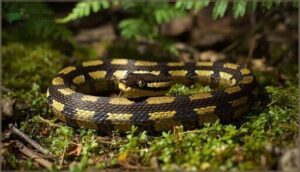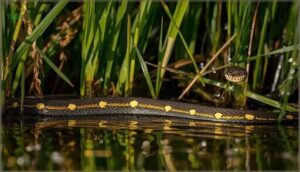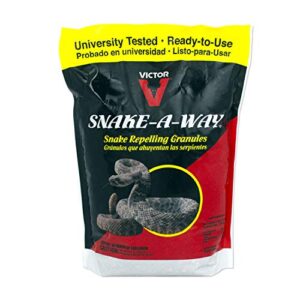This site is supported by our readers. We may earn a commission, at no cost to you, if you purchase through links.
You might spot a sleek garter snake gliding through your garden and wonder if it’s a harmless youngster or a fully grown adult. These common North American snakes don’t follow a one-size-fits-all rule—different species pack different lengths into surprisingly lightweight bodies.
The Common Garter Snake you see near your compost bin won’t grow anywhere near the size of its rare cousin, the Giant Garter Snake, which can stretch over five feet long. Females consistently outgrow males across all species, sometimes by nearly a third in both length and weight.
Understanding how big garter snakes get helps you identify what’s living in your yard, whether you’re a curious homeowner or an aspiring herpetologist tracking local wildlife.
Table Of Contents
- Key Takeaways
- Typical Size Range of Garter Snakes
- Size Comparison Among Well-Known Species
- Factors Influencing Garter Snake Growth
- Measurement Methods for Garter Snake Size
- Top 3 Garter Snake Repellents
- Frequently Asked Questions (FAQs)
- What is the size of a fully grown garter snake?
- How old do garter snakes get?
- How big does a yellow throated garter snake get?
- What is a garter snake?
- What are the different types of garter snakes?
- How big does a Mexican wandering garter snake get?
- What is the average length of a garter snake?
- How many species of garter snakes are there?
- What is the range of garter snakes in Canada?
- What is the diet of garter snakes?
- Conclusion
Key Takeaways
- Most adult garter snakes measure 2 to 3 feet long and weigh around 5 ounces, but size varies dramatically by species—from the compact Butler’s at 15-20 inches to the Giant Garter Snake stretching past 5 feet.
- Females consistently outgrow males by 10-30% in both length and weight across all species, a size difference that appears within three weeks of birth and reflects evolutionary pressure favoring larger females for reproduction.
- Newborn garter snakes start at just 5-9 inches and grow rapidly during their first year—adding roughly 1 cm per week—before slowing down after reaching sexual maturity around 55 cm at 2-3 years old.
- Diet quality, habitat conditions, and feeding frequency directly impact growth rates, with well-fed snakes in prey-rich environments growing significantly larger than those in resource-poor habitats.
Typical Size Range of Garter Snakes
If you’ve ever spotted a garter snake in your backyard or thought about keeping one as a pet, you’re probably wondering just how big these little guys actually get. The truth is, garter snakes don’t grow very large compared to other snake species, but their size can vary quite a bit depending on their age and sex.
Let’s break down what you can expect regarding their typical length and weight.
Average Adult Length and Weight
Garter snake size varies across species, but most adults measure 60 to 90 cm—that’s roughly 2 to 3 feet long. You’ll usually see them weigh around 150 grams, or about 5.3 ounces. Sexual dimorphism is common; females usually outgrow males by 10 to 30% in both length and weight. The weight-length ratio stays slender, making these snakes lightweight for their size.
Their vibrant colors are due to longitudinal stripe patterns.
Size at Birth and Juvenile Growth
Newborn garter snakes measure 12 to 23 cm at birth, roughly 5 to 9 inches. You’ll notice neonate size variation across populations—plains garter snakes can range from 12 to 24 cm, reflecting geographic differences.
Juvenile garter snakes grow fast early on, adding about 1 cm per week their first year. This indeterminate growth continues throughout life, but juvenile development slows after reaching sexual maturity size around 55 cm by year two or three.
In Colorado, the red-sided gartersnake can reach 124 cm.
Sexual Dimorphism in Size
Beyond age, sexual dimorphism in snakes affects garter snake size considerably. Female size bias is the rule—you’ll find adult females about 5–15% longer than males in most garter snake species variations.
This size difference appears within three weeks of birth, driven by hormonal control that slows male growth. Gape dimorphism and tail length also differ by sex, reflecting fecundity selection favoring larger females for reproduction.
Size Comparison Among Well-Known Species
Not all garter snakes are created equal in terms of size. Some species stay compact and slender, while others can stretch to surprising lengths.
Let’s look at how the most common species measure up so you can get a better sense of what to expect.
Common Garter Snake (Thamnophis Sirtalis)
You’re looking at North America’s most widespread species when you meet the common garter snake (Thamnophis sirtalis). This adaptable serpent commonly reaches 46–76 cm in adult size, though unusual individuals top 130 cm. Neonates measure about 12–23 cm at birth. Sexual maturity arrives around 1.5–2 years, when your snake’s growth rate slows after rapid juvenile development.
| Measurement | Typical Range | Notes |
|---|---|---|
| Adult size | 46–76 cm | Females consistently larger |
| Maximum length | 131–137 cm | Rare outliers documented |
| Neonate length | 12–23 cm | Fully independent at birth |
| Sexual maturity | 1.5–2 years | 55+ cm length typical |
| Wild lifespan | ~2 years average | Captive: 6–10+ years possible |
Females outgrow males early, producing larger litters as they mature. Understanding garter snake growth and development helps you recognize healthy individuals across garter snake species variations.
Plains Garter Snake (Thamnophis Radix)
Moving west across prairies, you’ll encounter the Plains Garter Snake (Thamnophis radix), averaging 36–76 cm in adult size. Neonate growth begins at 12–24 cm, with sexual dimorphism favoring larger females. Diet effects show strongly in wetland populations, where abundant frogs fuel rapid gains. Habitat influence matters—prey-rich sites produce bigger snakes. Maturity age generally arrives at 2–3 years.
| Measurement | Typical Range |
|---|---|
| Adult snout–vent length | 30–85 cm |
| Neonate total length | 11.9–24.1 cm |
| Female body mass | Up to 150+ g |
Giant Garter Snake (Thamnophis Gigas)
California’s giant garter snake (Thamnophis gigas) tops the size chart, reaching 94–165 cm—some stretch past five feet. You’ll find this threatened State Snake in Central Valley wetlands, where habitat loss has shrunk populations by over 90%. Diet specialization on fish and frogs, plus wetland dependence, make conservation efforts critical for recovery across isolated marshes and rice fields.
California’s giant garter snake stretches past five feet, making it the largest species despite habitat loss threatening 90% of its wetland populations
| Measurement | Range |
|---|---|
| Adult total length | 94–165 cm |
| Maximum documented | ~163 cm (64 in) |
| Common adult length | ≥120 cm |
| Body build | Sturdy, keeled scales |
| Conservation status | Threatened (federal & state) |
Eastern Ribbon Snake (Thamnophis Sauritus)
Eastern Ribbon Snake (Thamnophis sauritus) adults stay slimmer than giants, spanning 46–86 cm—you’ll spot sexual dimorphism with females longer than males. Neonate growth starts at 16–24 cm, reaching adult size in two years.
Four subspecies variations show consistent average length across regions, while life history ties maximum recorded length (89–91 cm) to wetland habitats.
| Measurement | Male | Female |
|---|---|---|
| Adult total length | ~429 mm | ~498 mm |
| Neonate size | 16–24 cm | 16–24 cm |
| Maturity threshold (SVL) | ~330 mm | ~380 mm |
Western Terrestrial Garter Snake (Thamnophis Elegans)
Western Terrestrial Garter Snake (Thamnophis elegans) adults generally reach 46–109 cm, with females stretching 80–90 cm while males stay smaller at 60–80 cm—sexual dimorphism you’ll notice across populations. Newborns start around 23 cm, maturing by age two.
Habitat variation from sea level to 3,993 m elevation creates dramatic garter snake size variations, with some Montana adults spanning 41–109 cm within one state alone.
| Measurement | Male | Female |
|---|---|---|
| Adult total length | 60–80 cm | 80–90 cm |
| Average mass | ~150 g | ~150 g+ |
| Neonate size | ~23 cm | ~23 cm |
Other Notable Species and Their Sizes
You’ll find Butler’s garter snakes among the smallest, averaging just 15–20 inches, while checkered garter snakes stretch 18–42 inches, with females reaching nearly four feet. Northwestern garter snakes stay compact at 13–38 inches, but western ribbon snakes can surprise you at 17–50 inches. Aquatic and Sierra garter snakes fall mid-range at 18–40 inches, showing how species dictate garter snake sizes.
| Species | Average Length | Maximum Recorded Length |
|---|---|---|
| Butler’s | 15–20 in | 29 in |
| Checkered | 18–22 in | 42.8 in |
| Northwestern | 12–24 in | 38 in |
| Western Ribbon | 24–36 in | 50 in |
Factors Influencing Garter Snake Growth
Garter snakes don’t all grow at the same pace, and several key factors determine how large your snake will ultimately become. Everything from what they eat to where they live plays a role in their development.
Let’s look at the main influences that shape a garter snake’s growth from hatchling to adult.
Diet and Nutritional Impact
What you feed your garter snake directly shapes how fast and large it grows. Prey protein levels, feeding frequency, diet diversity, and seasonal feeding patterns all play important roles in dietary influence on snake development.
- Prey quality matters: High-protein foods like earthworms and amphibian larvae fuel faster growth rates in juvenile snakes
- Feeding schedule counts: Regular meals every few days support steady weight gain and healthy body condition
- Variety prevents deficiencies: Rotating fish, worms, and invertebrates provides balanced nutrition better than single-prey diets
- Food limitation stunts size: Snakes in prey-poor habitats grow slower and reach smaller adult sizes than well-fed individuals
Habitat and Environmental Conditions
Where your garter snake lives significantly influences its growth. Factors such as temperature gradients, humidity levels, and environmental enrichment play crucial roles. Snakes in ideal natural habitats with proper climatic conditions tend to grow larger than those in suboptimal environments.
| Environmental Factor | Impact on Growth |
|---|---|
| Temperature range | Warmer areas speed metabolism and growth |
| Moisture availability | Humid climates support shedding and health |
| Shelter quality | Secure dens reduce stress, promote feeding |
| Activity season length | Longer warm periods extend feeding windows |
| Prey abundance | Resource-rich habitats produce larger adults |
Ideal enclosures should mimic these natural habitat conditions to ensure your garter snake thrives. This includes maintaining basking zones between 85-90°F, cool sides at 75-80°F, and humidity levels of 35-60%.
Molting and Growth Spurts
Beyond habitat, your snake’s molt cycles drive its growth spurts. Young garter snakes shed every three to four weeks, gaining roughly 3% body mass daily between molts when food is plentiful. Shedding frequency slows as they mature, dropping to six-week intervals in adults.
Behavioral changes appear before each molt—your snake’s feeding drops during the “blue-eyed” stage, then post-molt gain accelerates as appetite returns and energy allocation shifts toward new tissue.
Age and Maturation Rates
Age drives your snake’s reproductive timeline. Males reach sexual maturity around 1.5 years, while females mature closer to 2–3 years.
First-year growth is explosive—juveniles stretch from 6 inches at birth to nearly 2 feet by year’s end. After that, growth patterns shift: females keep growing to boost reproductive output, while males plateau earlier.
Most wild garter snakes live 4–6 years, giving them several breeding seasons once adult growth stabilizes.
Measurement Methods for Garter Snake Size
Getting an accurate measurement of your garter snake isn’t as straightforward as it might seem. You’ll need the right approach to avoid common mistakes that can throw off your numbers.
Let’s walk through the best methods to measure your snake, what to watch out for, and why keeping track of size matters for their health.
How to Accurately Measure Length
You’ll get the most reliable snake length data when you follow proper measurement techniques. Digital imaging methods using software like Snakemeasurer offer precision for garter snake size determination, while traditional tapes and restraint techniques work well too. Protocol considerations matter—measuring snout-vent length ensures accuracy even with tail damage.
Here’s your straight length measurement toolkit:
- Place your snake in a clear tube to keep it still and reduce struggle during handling
- Use soft tape alongside the body from snout tip to tail tip for total length measurements
- Try overhead photography with a ruler in frame for contactless digital imaging analysis
- Measure snout-vent length with calipers when you need the most consistent snake growth tracking
Common Errors in Size Assessment
When you rely on eyeballing alone, visual overestimation inflates garter snake size determination by 20–30%, especially for individuals over a meter. Misidentification between species and metric inconsistency (total length versus snout-vent length) further cloud accurate garter snake measurement methods.
Stretching errors from handling technique and muscle relaxation can add or subtract length, while shed skin stretches 15–30% beyond true size.
| Error Type | Impact on Measurement |
|---|---|
| Visual overestimation | 20–30% inflation of length |
| Stretching errors | Variable bias from handling force |
| Shed skin reliance | 15–30% overestimation |
| Species misidentification | Wrong size range assignment |
| Metric inconsistency | Confusion between total vs. snout-vent length |
Importance of Regular Size Monitoring
Tracking your snake’s dimensions over time turns raw numbers into a health indicator, revealing growth rates that flag underfeeding or illness early. Repeated measurements support reproduction planning, disease detection before symptoms worsen, and conservation management decisions in wild populations.
For captive garter snakes, consistent monitoring ensures juveniles hit developmental milestones and adults maintain peak condition throughout their lifespan.
Top 3 Garter Snake Repellents
If you’re looking to keep garter snakes away from your yard or garden, you don’t have to resort to drastic measures. There are several commercially available repellents designed to discourage snakes from entering specific areas without harming them.
Here are three popular options that many homeowners find effective.
1. Ortho Snake B Gon Repellent Granules
Ortho Snake B Gon Repellent Granules offer a practical approach when you’re managing garter snake activity around your property. Each 2 lb bottle covers up to 1,440 square feet, with granule effectiveness lasting approximately 30 days under typical weather conditions. You’ll need to reapply after heavy rainfall, though.
The formulation produces a noticeable floral or cinnamon-like scent despite “no-stink” marketing claims. Application frequency remains straightforward: shake the bottle side-to-side along perimeters.
Safety concerns are minimal when used as directed around people and pets, though you should avoid edible garden areas entirely.
Best For: Homeowners in snake-prone areas who want a non-toxic, easy-to-apply deterrent for keeping garter snakes away from outdoor living spaces like patios, garages, and woodpiles.
- Covers a large area (1,440 sq. ft. per bottle) and is safe to use around kids and pets when applied correctly
- Simple shake-and-apply method makes treatment quick without needing special equipment
- Works as a behavioral deterrent rather than a poison, so you’re not harming snakes or the environment
- Needs reapplication every 30 days (or sooner after rain), which adds up in cost and effort over time
- Results vary widely—some users see zero snakes while others report continued activity within days
- Despite being marketed as “no-stink,” it actually has a strong floral or cinnamon smell that some people find unpleasant
2. Victor Snake A Way Repellent Granules
Victor Snake-A-Way Repellent Granules work by disrupting a snake’s chemosensory perception through naphthalene and sulfur—active ingredients that interfere with the Jacobson’s organ.
You’ll get EPA-registered repellent efficacy covering up to 417 linear feet with a 4 lb bag, lasting 2–3 months under normal conditions. Application rates require a continuous perimeter band around structures.
Safety concerns arise from toxicity to fish and the strong mothball odor, so follow handling precautions carefully.
While university testing reports a 91% repellent rate against garter snakes, effectiveness varies with snake environment and reapplication timing after heavy rain.
Best For: Homeowners looking for an EPA-registered outdoor snake deterrent around structures, yards, and non-edible landscaped areas who can tolerate a strong mothball smell.
- Covers a large area with one 4 lb bag treating up to 417 linear feet of perimeter or over 10,000 square feet broadcast
- Long-lasting protection for 2–3 months per application under normal weather conditions
- University-tested formulation reports 91% effectiveness against common species like garter snakes and rattlesnakes
- Strong, persistent mothball odor from naphthalene that many users find unpleasant
- Toxic to fish and aquatic life, requiring careful placement away from water sources
- Mixed real-world results with some customers reporting inconsistent effectiveness or short duration after rain
3. LEBMP Snake Repellent Pouches for Yard
If you prefer a no-contact approach, LEBMP Snake Repellent Pouches deliver plant-based deterrence through eight pre-filled scent barriers. Natural ingredients like peppermint create an olfactory zone that discourages garter snakes—regardless of their snake size or growth stage—from entering yards, garages, and gardens.
Pouch effectiveness peaks at 2–3 months, though scent intensity fades faster in humid conditions. Placement strategies matter: distribute pouches around foundations, woodpiles, and entry points where even juvenile garter snakes might shelter.
Safety concerns remain minimal when you keep pouches away from children and pets, though the strong aroma can be overpowering indoors.
Best For: Homeowners who want a simple, plant-based deterrent to keep snakes out of yards and garages without handling granules or sprays.
- Eight ready-to-use pouches made from natural ingredients that are safe around kids, pets, and plants when used properly
- Long-lasting protection of 2–3 months per deployment, reducing the need for frequent reapplication
- Easy placement around foundations, woodpiles, and entry points with no mixing or mechanical setup required
- Strong peppermint scent can be overwhelming, especially in enclosed spaces like garages or sheds
- Effectiveness varies by snake species and environment, with scent fading faster in humid conditions
- Limited scientific validation, with most support coming from user reports rather than controlled field studies
Frequently Asked Questions (FAQs)
What is the size of a fully grown garter snake?
While some garter snakes stay compact at under 20 inches, others stretch past three feet. Most adult Thamnophis species reach 22–32 inches long, with females usually outgrowing males.
How old do garter snakes get?
In the wild, garter snakes generally live 2 to 4 years, while captivity extends their lifespan to 8–10 years on average, with unusual individuals reaching nearly 20 years under careful care.
How big does a yellow throated garter snake get?
You might wonder if this subspecies differs much from others. Adult yellow-throated garter snakes (Thamnophis proximus rubrilineatus) generally reach 60 to 90 cm, though females can grow up to 137 cm, showing clear sexual dimorphism.
What is a garter snake?
You’ll find garter snakes throughout North America—small, slender members of the genus Thamnophis.
These common species sport distinctive stripes, possess mild venom, and occupy wetlands, grasslands, and suburban areas across the continent.
What are the different types of garter snakes?
Scientists classify about 35 garter snake species across Thamnophis, with subspecies variations creating even more diversity. Regional differences produce distinct color morphs—from striped patterns to nearly all-black individuals—making species identification challenging but fascinating.
How big does a Mexican wandering garter snake get?
The Mexican wandering garter snake stays quite small—adult females reach only 40 to 50 centimeters in total length. Males are even shorter, reflecting typical sexual dimorphism among garter snakes.
What is the average length of a garter snake?
Most adult garter snakes measure between 46 and 137 cm in total length. You’ll find the common garter snake usually reaches 55 cm, though females often exceed 90 cm while males average 76 cm.
How many species of garter snakes are there?
The genus Thamnophis contains 37 recognized species according to recent taxonomic revisions, though you’ll see counts ranging from 35 to 37 depending on the source and subspecies classifications used.
What is the range of garter snakes in Canada?
You’d think Canada’s cold would keep snakes away, but garter snakes thrive coast to coast—from British Columbia to the Maritimes, even reaching the Northwest Territories’ sub-Arctic edge.
There, regional populations occupy diverse habitat types despite harsh northern limits.
What is the diet of garter snakes?
Your garter snake’s diet centers on small prey like frogs, earthworms, slugs, and fish.
Feeding frequency varies by age—juveniles eat every other day, while adults need meals weekly or biweekly depending on prey type.
Conclusion
Regarding understanding how big garter snakes get, size truly depends on the snake. From the compact Eastern Ribbon Snake to the impressive Giant Garter Snake, each species brings its own dimensions to your backyard ecosystem.
Females are the larger sex, often outweighing males substantially. By knowing these size differences, you can identify your garden visitors with confidence and appreciate the striking diversity living right outside your door.
- https://en.wikipedia.org/wiki/Garter_snake
- https://animaldiversity.org/accounts/Thamnophis_radix/
- https://fieldguide.mt.gov/speciesDetail.aspx?elcode=aradb36130
- https://www.snakesforpets.com/how-big-are-baby-snakes-when-they-are-born/
- https://bioone.org/journals/journal-of-herpetology/volume-44/issue-1/08-337.1/Abundance-and-Sexual-Size-Dimorphism-of-the-Giant-Gartersnake-Thamnophis/10.1670/08-337.1.full


















